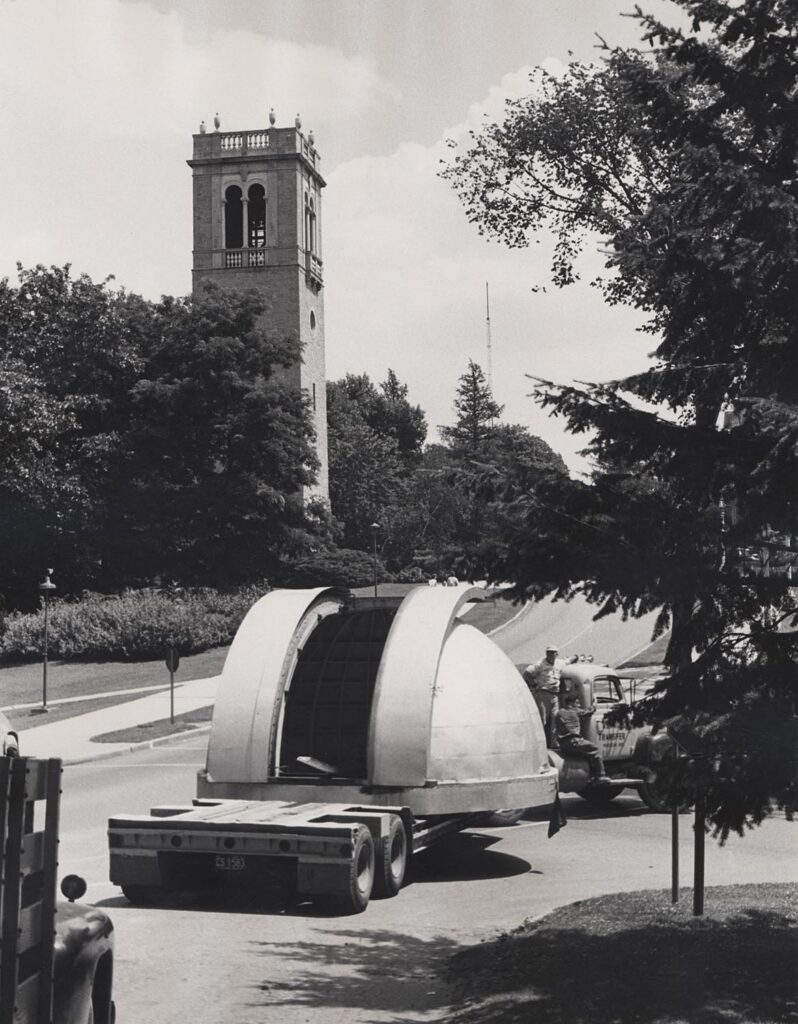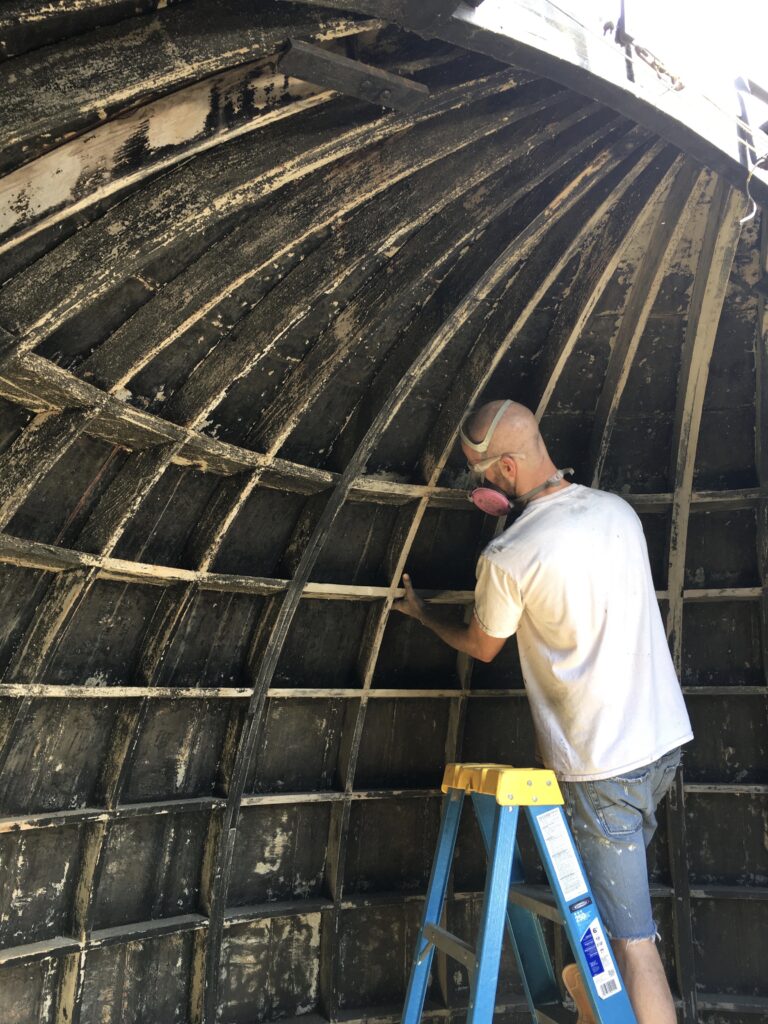
On a hill at the top of the Promega Madison campus, an old observatory overlooks the city of Fitchburg, Wisconsin. Inside, cutting-edge telescopes are ready to give students and astronomers breathtaking views of the cosmos.
Over the past 140 years, this observatory has served as the first launchpad for storied careers in astronomy. Following a relocation, it gave a passionate community a home for their curiosity. Today, it supports modern research while also welcoming stargazers of all ages. It is now one of the oldest operational observatories in the United States. This is the Bell Burnell Observatory.
History of the Bell Burnell Observatory
1882: Student Observatory Opens at the University of Wisconsin – Madison
Long before it stood atop a hill on the Promega campus, the Bell Burnell Observatory began its life as the Student Observatory at the University of Wisconsin-Madison.
James C. Watson was the first director of the Washburn Observatory at the University of Wisconsin. At the time, Watson was a renowned astronomer who previously directed the observatory at the University of Michigan. Watson discovered many asteroids and searched extensively for a hypothetical planet named “Vulcan” between Mercury and the Sun.

Watson had an intense focus on research and did not savor having to share space at the Washburn Observatory with students. To fix his sorry situation, he personally funded the construction of a student observatory adjacent to Washburn. Unfortunately, Watson died before the student observatory opened in 1882.
The student observatory housed a 6-inch refractor telescope under a dome that rotated in a complete circle. This facility gave students such as George Comstock and Sidney Townley a space to launch their studies before moving into Washburn Observatory. Two major railroads depended on timekeeping performed in the observatory using the meridian transit. The Student Observatory was also used for the first North American measurements of atmospheric refraction and the constant of aberration.
Unfortunately, as the city of Madison grew, light pollution rendered the campus observatories less useful. The university built a new observatory in Pine Bluff, WI, and both Washburn and the student observatory became inactive.
1960: Student Observatory Moves to Fitchburg

In 1959, the university extended an offer to the Madison Astronomical Society (MAS). The university would donate the building to MAS as long as MAS could facilitate moving it away from campus. By this time, the student observatory had not been used in several decades.
The opportunity to take control of the student observatory was too good to pass up. With the financial support of amateur astronomer Oscar Mayer, MAS relocated the observatory to its current location during the summer of 1960.
This relocation took many months of dedication and hard work. Several young members of the MAS Junior Society spent the summers of 1959 and 1960 slowly cutting through the massive 4×8” beams that formed the structure of the observatory. They also had to dig out the foundation of the building to sever the bolts that held the structure in place. On July 19, 1960, the building was moved in three pieces. It was subsequently known as the Oscar Mayer Observatory.

For over 20 years, the Madison Astronomical Society regularly hosted social gatherings and observations at the Oscar Mayer Observatory. By the mid-80s, the lights and pollution of Madison were once again hindering their observational abilities. In 1984, MAS relocated their activities to a new facility and the observatory once again went dormant.
The day of the move was exciting. There was a narrow twisty road up to the small hilltop, and here comes a truck-mounted crane and a flatbed truck. They slowly picked up each half of the building – very slowly at first while we all looked for a hang-up on an undetected bolt, and set it on the flatbed. … When we got out there, the crew set the two parts of the building down on the foundation, being careful with the new telescope pier, and got the two parts aligned within a gnat’s eyebrow.”
John Rouse, Junior Society Member, as told to MAS Historian John Rummel.

2017: A New Chapter for the Observatory
In 2017, Promega Founder and CEO Bill Linton began funding renovations to the observatory. Promega owned the land on which the building sat, and Bill dreamed of restoring it to working condition and making it available to the community. He enlisted Promega facilities personnel, artisan woodworkers, and a network of professional and amateur astronomers to design and build the future of the 140-year-old building.
The renovations were completed in 2021. The interior of the observatory now features inlaid wood floors and a library with built-in hardwood shelves. The movable dome has been restored, housing state-of-the-art reflector and refractor telescopes with cameras to capture images of near and far celestial objects.
A New Name: The Bell Burnell Observatory
In 2022, Bill Linton proposed naming the restored observatory after Professor Dame Jocelyn Bell Burnell. Jocelyn Bell Burnell is an astronomer best known for discovering the rapidly spinning neutron stars later named “pulsars” while she was a graduate student at the University of Cambridge.
Jocelyn Bell Burnell has shown a lifelong commitment to supporting women and other marginalized groups in astronomy. After receiving a Special Breakthrough Prize in Fundamental Physics in 2018, she used the prize money to establish a scholarship fund aimed at supporting students from underrepresented background. Throughout her long career, she championed the belief that anyone can make the next big discovery, and it is this belief that Bill hopes to affirm in the newly dedicated Bell Burnell Observatory.
Dr. Bell Burnell accepted the invitation, and on September 7, 2022, she will be joining Bill Linton in pulling back the cover to reveal the new sign outside the completed observatory, officially christening it The Bell Burnell Observatory.
The Future of The Bell Burnell Observatory

140 years after it first opened, this historic observatory will once again welcome curious stargazers of all ages. Educational programs run by the BTC Institute will give students, teachers and community members unique access to immersive, hands-on experiences. These programs are supported by a dedicated education fund established by Bill Linton and Dargar Bjorksten. BTC Institute also receives NASA support through the Wisconsin Space Grant Consortium.
As the next chapter in the story begins, the Bell Burnell Observatory will continue to be a place of learning and exploration for the Madison area.
Research at the Bell Burnell Observatory
In my research, I search for exoplanets, which orbit stars other than the Sun. I have been a frequent user of the Bell Burnell Observatory since November 2021, when Bill Linton gave me access to use the recently refurbished facility and its modern 16″ aperture Meade LX200 telescope. It is an awesome place to observe the night sky.”
Bob Aloisi, 3rd year graduate student at the University of Wisconsin – Madison
Learn more about the Bell Burnell Observatory at btci.org/bell-burnell-observatory.

The gentleman in the photo repairing the dome is Grant Merrill .:)
-Billy Eason
Thank you. We will modifiy the caption of the photo.